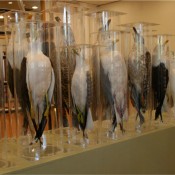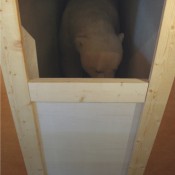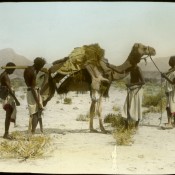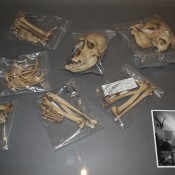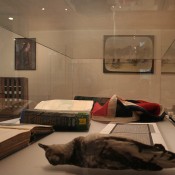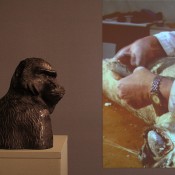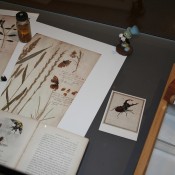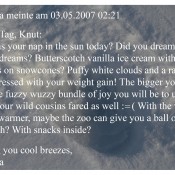Galleri Sverdrup, Georg Sverdrups hus, Blindern, Oslo. 11 May to 24 August 2012
When Liv Emma Thorsen offered us the opportunity to work with a team of academics engaged in a research project exploring “what is an animal?” its possibilities seemed tantalizingly irresistable. Through our own work we were already familiar with a number of the participants and on familiarizing ourselves further with all the research specific to this project, the respective papers, and consequent conversation through correspondence, we found the content sitting surprisingly close to our own concerns and artwork. As artists whose practice engages with human/animal relations and what they reveal about ourselves and our relationship to the environment, the question of representation – who speaks for whom? – is paramount. To translate a thought into an object, (and here it is hoped, objects into thoughts) and for it to carry particular meanings, also raises questions that are topical in the context of academia and artistic research. In our own artwork, relationality is of particular importance and in our contribution to this project we acknowledge and it is hoped, expose a complex web of meaning accretion. Significant resonance is present for instance within the narrative microcosm of each exhibit. In turn, it exists between all the exhibits, between the objects, the gallery space and their institutional context here and between these components and the specific wordling of the visitor to this exhibition. Here, discrete histories well up refreshingly from ancient artefacts and are revealed as subjective, intimate. As such they remind us that knowledge is always subject to revision and history can tell us not only why we are what we are today, but how else we can be.Animal Matters is a project residing somewhere between curatorial practice and the practice of art, leading amongst other productions including a book, to an exhibition in The Svedrup Galleri at the University of Oslo. This exhibition involved a collaboration with nine academics and their research arising from a number of discrete fields across the humanities and sciences.
As artists whose research-based practice engages strategically with human-animal relations and what these can reveal about our behaviour and our relationship to the environment, the question of representation – who is speaking for whom – is crucial. To translate a thought into an object, for it to carry a particular meaning also carries with it questions that are topical in the context of academia and artistic research. In our artwork, relationality is of great importance. It’s in the connection between things – for instance the objects in the exhibition – the objects and the exhibition space – the objects and the context of the exhibition – between part or all of these components and/or the worlding of the visitor to this exhibition – that the meanings are generated and take shape. In those moments of encounter, a shift in thinking is made possible. In that shift – in that destabilising, a door opens and beyond it, lies the possibility of new knowledge and of behavioural change
It is in the unreliability of objects that we find the significance of any display productively unstable, in flux and capable of offering not one but a multitude of narratives – by the removal of this or the addition of that – never individually to be trusted as conclusive. In this project therefore, it was in this precarious dynamic and the potentialities of an array of juxtaposed narratives, arcing between each other, that the fascination and the challenge lay.
So with this in mind there were many factors to consider in respect of the work of each of the nine researchers involved, Brian Ogilvie, Karen Rader, Siv Berg, Guro Flinterud, Nigel Rothfels, Brita Brenna , Adam Dodd, Liv Emma Thorsen, Henry McGhie.
Initially for us as artists, the task also raised questions relating to ownership and autonomy. In some senses we were approaching the project not only as artists but as curators – of material yes, but also of ideas. We say initially because these questions were soon put aside and we did rather plunge in with a degree of confidence concerning what would most certainly evolve. We mentioned already the issue of relationality, as being of high importance during the process of development in our artwork and indeed in our installation work. To evoke this relationality through disparate objects and to prime the potential conversation between a variety of assemblages requires an understanding also of spatial relations and how these relations might be usefully activated.
Our artwork critiques the flawed application of representations (and animal representations in particular) – conveniences we have become accustomed to digesting without thinking. We take these representations as they appear within the context of art, popular culture and historical collections and by a process of often seemingly slight adjustment or careful juxtaposition, we shift a balance within pre-coded framings of the ‘image’. It is within the second, longer look by the viewer, this prompt to think again and in the resultant space of unexpected affect (humour, dissonance, surprise) that the art functions.
